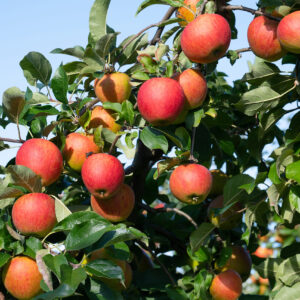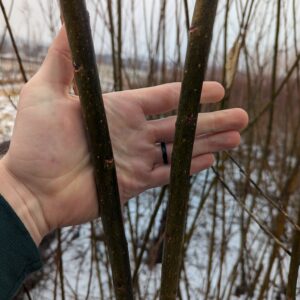Willows and poplars are some of my absolute favorite silvopasture trees. They are cheap, easy to work with, very forgiving, propagate super simply, and give shade faster than just about anything else. While they may not have the upside of a Millwood honey locust, Illinois Everbearing mulberry or Yates persimmon, they do so well as a fast-growing, inexpensive shade tree that they more than earn their place in a silvopasture system. The ability to live-stake these trees by simply taking a dormant branch or pole and jamming it in the ground is what makes these trees stand out.
We typically integrate them as fast-growing shade trees, with the option to use them for fodder or timber. Willows are more of the fodder tree, since they put out more leaf biomass and their wood isn’t as useful as poplar wood, while poplars are more readily used for timber. [I should note that when I say poplars in this case, I’m talking about hybrid poplars, not tulip poplars. Very different trees. Tulip poplars are also great, fast-growing and produce better timber, but don’t live-stake, so they are not as easy to propagate.]
A large part of my inspiration to start planting willows and poplars came from New Zealand, particularly a fantastic series of videos which I first watched about 6 years ago. In it, they showed a very simple system that is quite widespread and well-established over there, which I thought needed to be applied here in the US. So, in the spring of 2019 I started my first planting, with the aim of some being able to replicate the New Zealand work.
Writing at the end of 2023, I can say that it’s been a true success. While there’s certainly more refining to do as we learn more about the details of how these are grown in New Zealand, and how we can adapt those principles to our different conditions, it’s pretty clear that this works very well. And it’s a hit. Planting big livestakes gives about as much instant-gratification as you can get in the silvopasture realm. It’s wonderful to walk away from a planting with 10’ trees sticking out of the ground, knowing that you already have a very substantial tree that’ll start contributing shade within 2-3 years.




Given our initial success with a very small nursery, we are actively scaling up our production. It’ll take time, but we have around 5,000 stems in the ground for pole production, with the aim of 10’ poles with several inches of caliper. We will likely continue to scale up our poplar pole production over time, but there is one main limiting factor: shipping.
Since these poles are big, heavy, and cumbersome, they absolutely do not ship well. I had a shipment of 8’ willow live stakes arrive this spring, and they were terrible to unload from the truck. I don’t even know if 10’ poles, which is the NZ standard, could practically be shipped on a standard freight truck, and if they could, the cost would be very high, and the challenge of loading and unloading would be significant. You’d need a very large shipment to make it worthwhile, and anyone needing just a few dozen or even a few hundred poles likely couldn’t justify the shipping costs. These are trees that are best considered ‘local pick-up only’.
As much as I would love to buy 1,000 flat, low-lying acres and start planting it all into willows and poplars for one big centralized nursery, what we’ll really need are many, many local nurseries spread throughout the country. Some may churn out 100,000 stems per year and serve a region, while others might be on-farm nursery blocks that only need to make a few dozen poles a year to expand the farm’s shade. New Zealand has a huge network of regional nurseries specifically growing willows and poplars, as well as a dedicated educational nonprofit. Given their ability to provide quick shade in a very cost-effective way, the opportunity is there to see a similar network in the US.
I should note that there is certainly money to be made here as well. For example, this company in New Zealand offers willow and poplar planting as part of their suite of services, and looks to have it down to a science. When you convert New Zealand government nursery pricing per pole (materials only, not labor) from NZD to USD, it comes to almost $11 per pole. Not bad for a tree from a very low-maintenance nursery. It’ll take some years to establish, but once you have a coppice block going, the annual maintenance is very low.
So here’s where you come in. In order to move silvopasture forward, for more farmers to get the benefits of shade, fodder, timber, and more at prices they can afford, we need trees like these available all over the place. These are the easiest trees to start with and can give folks the experience and confidence needed to move on to more expensive or challenging trees like persimmons, oaks and hickories. Whether you start a nursery with 12’’ live stakes, or 12’ poles, it’s worth getting started soon, so you too can reap the reward and help spread silvopasture to your region.
If you want to buy plants to start your nursery, Hramor Nursery, Cold Stream Farm, and Musser Forest (as well as many others) have selections of poplar and willow that do well in silvopasture.



